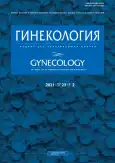Gynecological diseases as predictors of female sexual dysfunction
- 作者: Stenyaeva N.N.1, Chritinin D.F.2, Chausov A.A.1
-
隶属关系:
- Kulakov National Medical Research Center for Obstetrics, Gynecology and Perinatology
- Sechenov First Moscow State Medical University (Sechenov University)
- 期: 卷 23, 编号 2 (2021)
- 页面: 149-154
- 栏目: ORIGINAL ARTICLE
- URL: https://bakhtiniada.ru/2079-5831/article/view/71015
- DOI: https://doi.org/10.26442/20795696.2021.2.200784
- ID: 71015
如何引用文章
全文:
详细
Background. Female sexual dysfunction is extremely common and affects about half of the world’s women. Currently, the question of the relationship between gynecological morbidity in women and the characteristics of sexual activity and sexual functioning in a couple remains poorly understood.
Aim. To establish gynecological diseases associated with decreased sexual functioning, sexual health disorders in women on the basis of a screening assessment when visiting the clinic.
Materials and methods. We conducted a cross-sectional descriptive study of the sexual functioning of 1256 women who presented to outpatient appointments. Anamnestic and clinical methods were used, sexological testing using the Female Sexual Function Index questionnaire.
Results. Based on anamnestic data, screening assessment of sexual health and sexual functioning of 1235 women who applied for outpatient appointments to a gynecological clinic, a high gynecological and extragenital morbidity was established in patients (100%). The structure of gynecological diseases is represented by female infertility (48.3%), inflammatory diseases of the genital organs (38.5%; of which salpingo-oophoritis – 16.6% and vulvovaginitis – 15.9%), endometriosis (13.9%) , menstrual irregularities (8.3%), as well as pain disorders (8.1%). The incidence of infections, predominantly sexually transmitted, was revealed, among them papillomatous viral infection (8.3%), genital herpes (5.3%) and chlamydia (3.7%). It was found that in gynecological patients with diseases characterized by a chronic course, inflammation, pelvic pain, menstrual and reproductive disorders, sexual functioning significantly decreases (p=0.00) and sexual health is impaired. Sexual dysfunctions were detected in 21.6% of patients, their structure is represented by isolated (39.3%) and combined (60.7%) disorders of libido, orgasm, sexual anhedonia, failure of genital response, as well as dyspareunia, vaginismus. In 33.7% of patients, preclinical forms of sexual dysfunction were identified that did not meet the criteria for sexual dysfunction (did not cause distress, were short-lived), but confirmed by the analysis of patient complaints, as well as by the results of the Female Sexual Function Index questionnaire.
Conclusion. Thus, chronic gynecological diseases with inflammatory manifestations, pelvic pain, menstrual and reproductive dysfunctions are associated with decreased sexual functioning, sexual dysfunctions, and preclinical forms of sexual dysfunctions.
作者简介
Natalia Stenyaeva
Kulakov National Medical Research Center for Obstetrics, Gynecology and Perinatology
编辑信件的主要联系方式.
Email: nataliasten@mail.ru
ORCID iD: 0000-0002-6495-3367
Cand. Sci. (Med.), Kulakov National Medical Research Center for Obstetrics, Gynecology and Perinatology
俄罗斯联邦, MoscowDmitrii Chritinin
Sechenov First Moscow State Medical University (Sechenov University)
Email: nataliasten@mail.ru
ORCID iD: 0000-0001-9107-2357
D. Sci. (Med.), Prof., Acad. RAS, Sechenov First Moscow State Medical University (Sechenov University)
俄罗斯联邦, MoscowAndrei Chausov
Kulakov National Medical Research Center for Obstetrics, Gynecology and Perinatology
Email: andreaschausov@gmail.com
ORCID iD: 0000-0002-3094-7209
head of the information and analytical center, Kulakov National Medical Research Center for Obstetrics, Gynecology and Perinatology
俄罗斯联邦, Moscow参考
- Waite LJ, Laumann EO, Das A, Schumm LPh. Sexuality: Measures of Partnerships, Practices, Attitudes, and Problems in the National Social Life, Health, and Aging Study. J Gerontol B Psychol Sci Soc Sci. 2009; 64 B (Supp. l1): 56–66. doi: 10.1093/geronb/gbp038
- Crisp C, Vaccaro C, Fellner A, et al. The influence of personality and coping on female sexual function: a population survey. J Sex Med. 2015; 12: 109–15. doi: 10.1111/jsm.12735
- McCool ME, Zuelke A, Theurich MA, et al. Prevalence of female sexual dysfunction among premenopausal women: a systematic review and meta-analysis of observational studies. Sex Med Rev. 2016; 4: 197–212. doi: 10.1016/j.sxmr.2016.03.002
- McCool-Myers M, Theurich M, Zuelke A, et al. Predictors of female sexual dysfunction: a systematic review and qualitative analysis through gender inequality paradigms. BMC Womens Health. 2018; 18 (1): 108. doi: 10.1186/s12905-018-0602-4
- American Sexual Health Association. Understanding sexual health. 2018. Available at: www.ashasexualhealth.org/sexualhealth. Accessed: 19.12.2020.
- Rosen R, Brown C, Heiman J, et al. The Female Sexual Function Index (FSFI): a multidimensional self-report instrument for the assessment of female sexual function. J Sex Marital Ther. 2000; 26 (2): 191–208.
- Meston CM, Freihart BK, Handy AB, et al. Scoring and Interpretation of the FSFI: What can be Learned From 20 Years of use? J Sex Med. 2020; 17 (1): 17–25. doi: 10.1016/j.jsxm.2019.10.007
- Федорова А.И. Диспареуния у женщин в пре- и постменопаузальном периоде. Гинекология. 2016; 18 (1): 13–8 [Fedorova AI. Dyspareunia in pre- and postmenopausal women. Gynecology. 2016; 18 (1): 13–8 (in Russian)].
- Fairbanks F, Abdo CH, Baracat EC, Podgaec S. Endometriosis doubles the risk of sexual dysfunction: a cross-sectional study in a large amount of patients. Gynecol Endocrinol. 2017; 33 (7): 544–7. doi: 10.1080/09513590.2017.1302421
- Clayton AH, Goldstein I, Kim NN, et al. The International Society for the Study of Women’s Sexual Health Process of Care for Management of Hypoactive Sexual Desire Disorder in Women. Mayo Clin Proc. 2018; 93 (4): 467–87. doi: 10.1016/j.mayocp.2017.11.002
- La Rosa VL, De Franciscis P, Barra F, et al. Sexuality in women with endometriosis: a critical narrative review. Minerva Med. 2020; 111 (1): 79–89. doi: 10.23736/S0026-4806.19.06299-2
- Доброхотова Ю.Э., Камалов А.А., Слободянюк Б.А., и др. Особенности сексуальной функции у пациенток с пролапсом гениталий. Акушерство и гинекология. 2020; 8: 112–9 [Dobrokhotova IuE, Kamalov AA, Slobodianiuk BA, et al. Osobennosti seksual’noi funktsii u patsientok s prolapsom genitalii. Akusherstvo i ginekologiia. 2020; 8: 112–9 (in Russian)].
- Krapf JM, Mitchell L, Holton MA, Goldstein AT. Vulvar Lichen Sclerosus: Current Perspectives. Int J Womens Health. 2020; 12: 11–20. doi: 10.2147/IJWH.S191200
- Briedite I, Ancane G, Ancans A, Erts R. Insufficient assessment of sexual dysfunction: a problem in gynecological practice. Medicina (Kaunas). 2013; 49 (7): 315–20. PMID: 24375243.
补充文件









